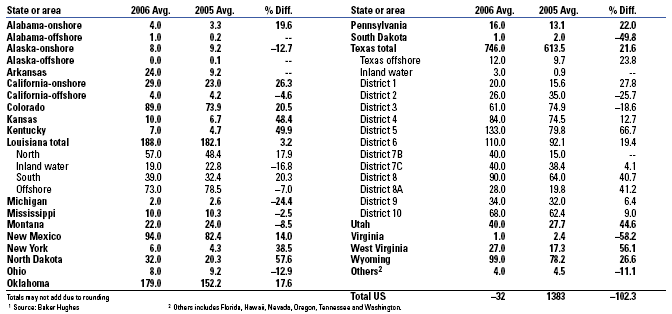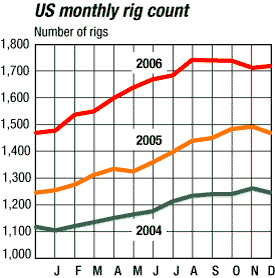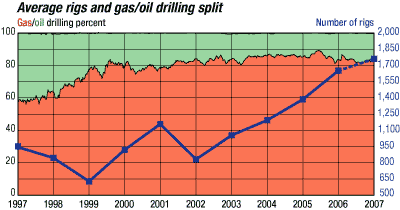OUTLOOK 2007: US ROTARY RIGS
US rig count continues to defy gravity
Offshore, rigs appear to be slowly exiting the US Gulf of Mexico, though not in a mass exodus, for greener waters offshore India, the Middle East and Southeast Asia. On land, there appears to be slower growth of coalbed methane wells.
In general, we saw indications of decreased rig efficiency scattered throughout the country as we analyzed the data on a state and district level, but is was most apparent in Texas. We cannot be certain, but this might be explainable by a slight deepening in average well depth, combined with newly created crews and the occasional old oil-technology rig.
The run-up in rigs was steep last year�a 19.4% year-to year average that greatly exceed our 12% forecast. This year, we are predicting a modest 6.9% increase, but that will likely be achieved by February of this year. This implies a flattening of the drilling rig curve, but it would be at a very high level. The BHI rig count would have to maintain 1,750 to 1,800 rigs throughout the year for the average yearly average of 1,769 to be achieved. According to the October ReedHycalog rig census, this is easily doable, with a total fleet of 2,300 available.
Operator surveys were extremely varied, with some pulling out of an area in a dramatic way, while others were moving in just as impressively. 
Average number of US rotary rigs in operation1
Click image to enlarge view
|
 |
|
These numbers, from Baker Hughes, represent only those rigs that are significant consumers of oilfield services and supplies. It does not include very small truck-mounted rigs or rigs that can operate without a permit. However, non-rotary rigs such as coiled tubing and workover rigs drilling new wells may be included. To be counted, a rig must be on location and be �actively� drilling. A rig is active from the moment the well is spudded until it reaches TD. Rigs that are in transit, rigging up, performing workovers, completions or production testing, are not counted.
|





